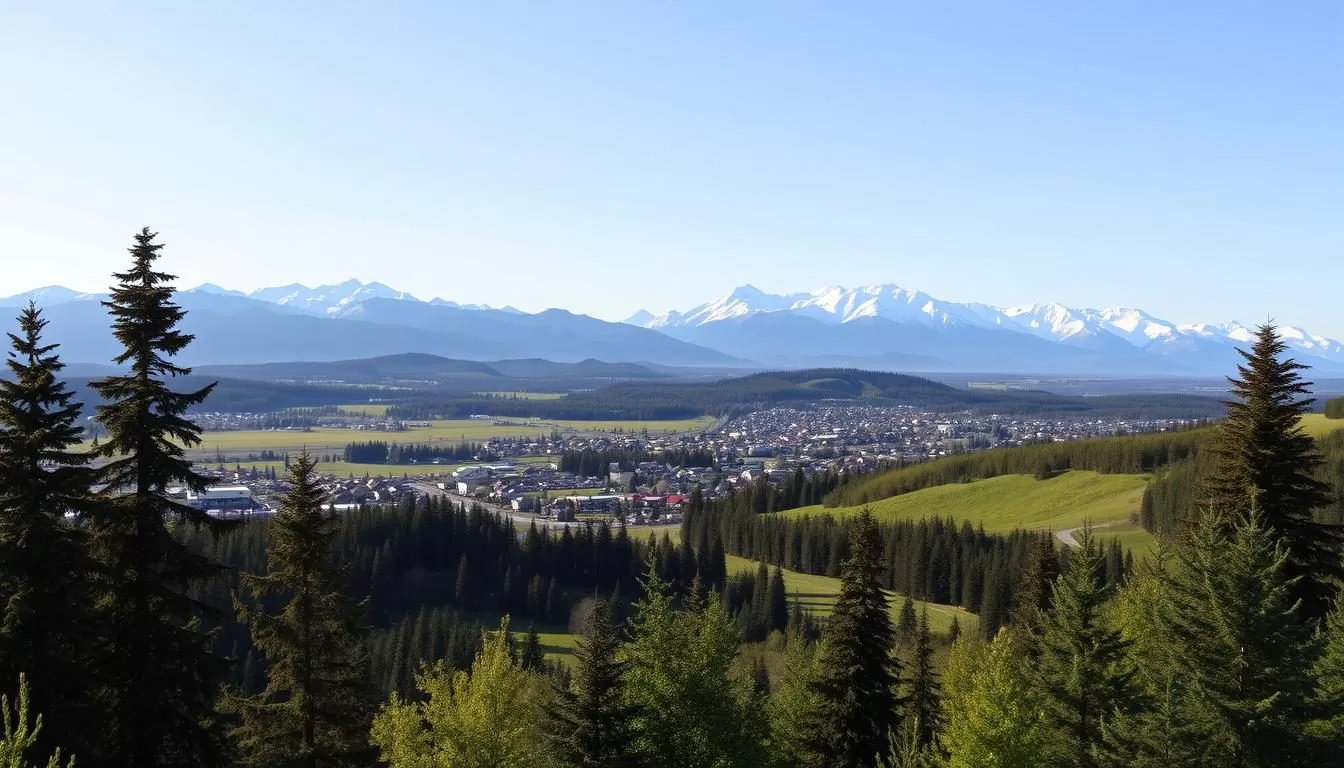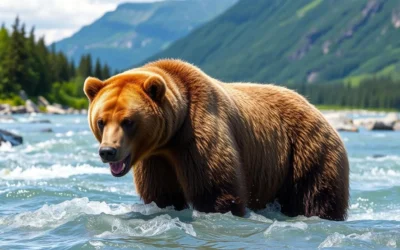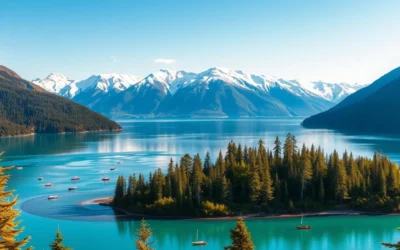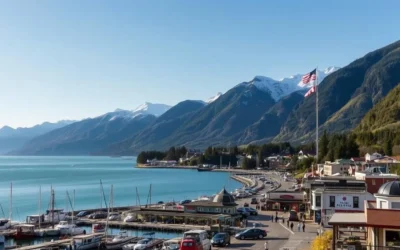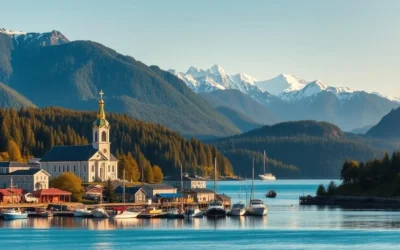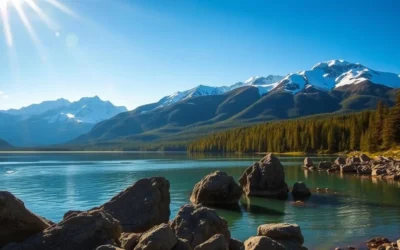✓ Accommodations✓ Flights✓ Rental Cars
Planning a trip to Wasilla can be a thrilling experience, especially when you’re aware of the seasonal changes that this Alaskan city has to offer.
Understanding the weather patterns is crucial for a successful trip that aligns with your outdoor activity preferences and sightseeing goals. The time of year you choose to visit Wasilla largely depends on what you want to experience, from the midnight sun to the northern lights.
Each season presents distinct advantages and challenges, with dramatic temperature variations and daylight fluctuations. This guide will help you navigate Wasilla’s climate to determine the ideal time for your trip.
Understanding Wasilla’s Unique Climate
Wasilla, Alaska, boasts a distinct climate that sets it apart from other destinations. Located in the heart of Alaska, Wasilla’s climate is shaped by its geography and proximity to the Matanuska-Susitna Valley.
Geographic Location and Its Impact on Weather
Wasilla’s location significantly influences its weather patterns. The city’s proximity to the mountains and its position in the valley contribute to its unique microclimate. Temperature fluctuations are common due to the surrounding terrain, which can trap cold air and create varied weather conditions.
Wasilla’s Four Distinct Seasons
Wasilla experiences four dramatically different seasons, each offering unique experiences. Here’s an overview of what to expect during each season:
- Summer brings long daylight hours with up to 19 hours of functional daylight and mild temperatures averaging 55-75°F.
- Fall transforms Wasilla with spectacular foliage and cooling temperatures between 30-55°F.
- Winter delivers the full Alaskan experience with temperatures often dropping below 0°F and limited daylight hours.
- Spring represents a transition period with gradually warming temperatures and rapidly increasing daylight hours.
| Season | Temperature Range (°F) | Daylight Hours |
|---|---|---|
| Summer (summer) | 55-75 | Up to 19 |
| Fall (fall) | 30-55 | Decreasing |
| Winter (winter) | Below 0 | 5-6 |
| Spring (spring) | 30-60 | Increasing |
Understanding these seasonal variations is essential for planning your trip to Wasilla and making the most of your visit.
Summer in Wasilla: The Peak Season
The summer months in Wasilla bring a unique blend of comfortable temperatures and almost 24-hour daylight, making it an ideal time for travel. During this period, the city is bustling with activities and events that cater to various interests.
June to August Temperature Ranges
Summer in Wasilla is characterized by mild temperatures, with daytime highs typically ranging from 65°F to 75°F (18°C to 24°C). June tends to be one of the drier summer months, making it excellent for outdoor exploration. July and August see a slight increase in temperature, with occasional warmer days.
Daylight Hours and the Midnight Sun Experience
One of the most distinctive features of Wasilla’s summer is the extended daylight. The city experiences almost 24-hour sunlight, with the sun setting around midnight and rising again just a few hours later. This phenomenon, known as the midnight sun, allows for extended outdoor activities and unique experiences like midnight hiking or fishing.
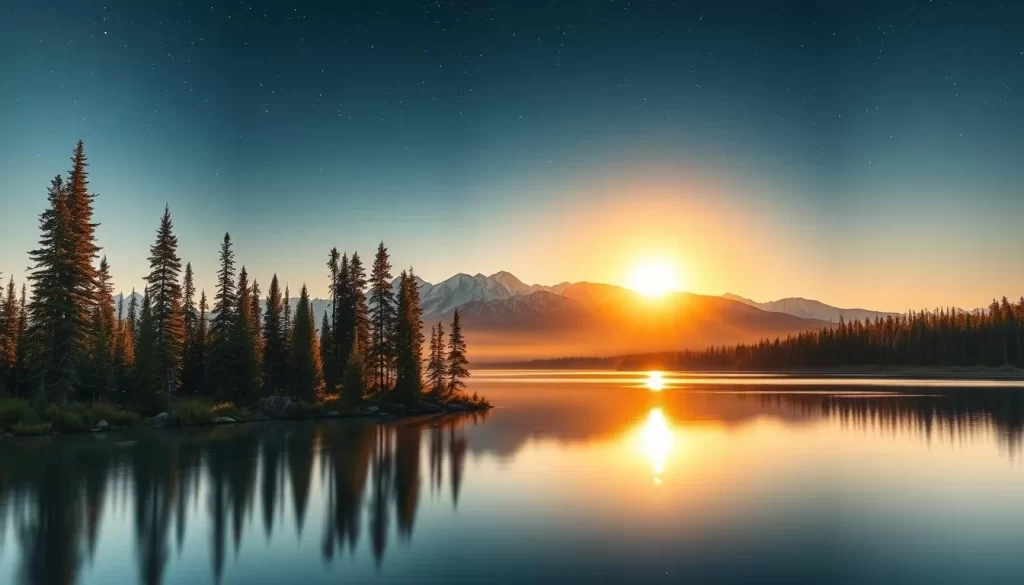
Summer Precipitation Patterns
Summer precipitation in Wasilla is relatively moderate, with average monthly rainfall between 1.5-2.5 inches. While June is generally dry, July and August see a gradual increase in rainfall, often in the form of gentle afternoon showers. The moderate precipitation contributes to the lush green landscapes and abundant wildflowers, making summer a visually appealing time to visit.
| Month | Average High Temperature | Average Rainfall |
|---|---|---|
| June | 70°F (21°C) | 1.5 inches |
| July | 75°F (24°C) | 2.0 inches |
| August | 72°F (22°C) | 2.5 inches |
Fall in Wasilla: A Colorful Transition
Autumn in Wasilla is a time of transition, marked by colorful foliage and shifting weather patterns. As the summer warmth dissipates, the landscape transforms into a vibrant tapestry of colors.
September to October Weather Conditions
During September and October, Wasilla experiences a gradual cooling trend. Average highs range from 56°F to 45°F, while lows can dip to around 39°F. This period is characterized by decreasing daylight hours and increasing precipitation.
| Month | Average High | Average Low | Precipitation |
|---|---|---|---|
| September | 56°F | 45°F | 2.5 inches |
| October | 45°F | 39°F | 3.2 inches |
Fall Foliage and Photography Opportunities
The fall foliage in Wasilla is a photographer’s dream, with vibrant colors and diverse landscapes. The combination of deciduous trees and evergreen forests creates a unique backdrop for capturing the northern lights later in the season.
Popular spots for photography include Hatcher Pass, Knik River Road, and the shores of Wasilla Lake.
Early Northern Lights Viewing
Fall marks the return of dark enough nights for northern lights viewing, with opportunities beginning in late August and improving throughout September and October. The best time to see
As the autumn equinox in late September is known for heightened aurora activity, it is a prime time to see the northern lights. Clear fall nights with minimal light pollution offer excellent conditions for viewing the aurora around Wasilla.
Winter in Wasilla: The Snowy Season
When winter arrives in Wasilla, the town is blanketed in snow. The winter season, spanning from November to March, brings a unique set of conditions that transform the landscape.
November to March Temperature Extremes
During these months, Wasilla experiences significant temperature fluctuations. November marks the beginning of the cold season, with temperatures gradually dropping. By December and January, the temperatures reach their lowest, often below 0°F (-18°C). February and March see a slight rise in temperatures, but it remains chilly.
Snow Conditions and Accumulation
Snowfall is a significant aspect of Wasilla’s winter. The snow accumulation varies, with some years receiving more snow than others. The snow conditions are generally suitable for winter sports, making it a popular time for activities like skiing and snowmobiling.
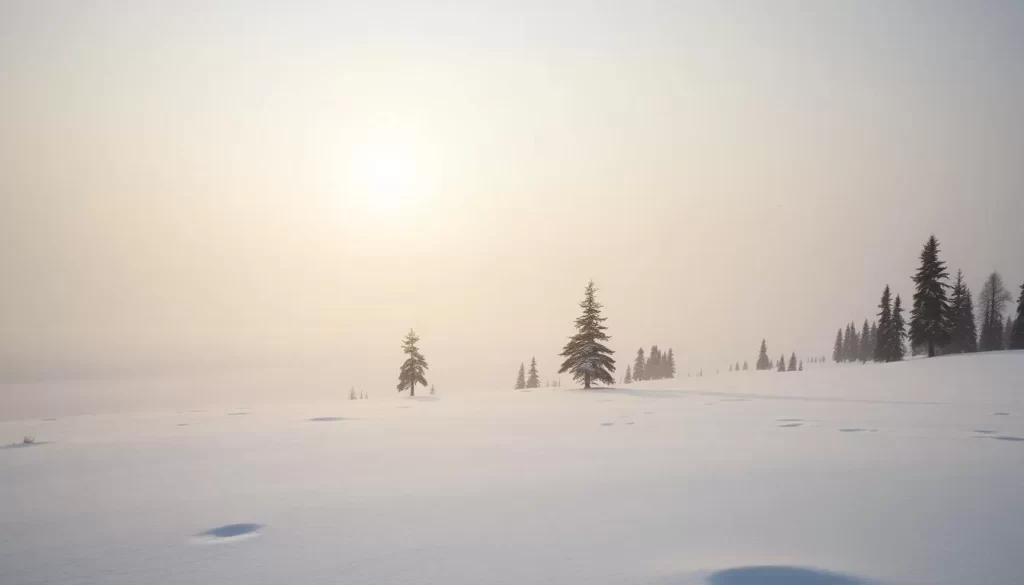
Winter Daylight Hours
The daylight hours in Wasilla during winter are notably short. November starts with about 8 hours of daylight, reducing to 6 hours by the end of the month. December has the shortest hours daylight, with the solstice having just 5.5 hours of functional daylight. January begins the gradual recovery, gaining about 5 minutes of daylight daily. By March, the hours of daylight increase significantly, reaching nearly 12 hours by the spring equinox.
This variation in daylight affects the planning of outdoor activities. Despite the short days, the low-angle sunlight creates a beautiful golden light, appreciated by photographers.
Spring in Wasilla: The Awakening
As winter’s chill begins to dissipate, Wasilla awakens from its slumber, ushering in the vibrant season of spring. This transitional period brings about significant changes in the environment and available activities.
April to May Weather Patterns
During April and May, Wasilla experiences a gradual warming trend, with temperatures rising steadily as the time passes. The weather patterns during these months are characterized by increasing daylight hours and melting snow. As the snow melts, the landscape transforms, revealing new vistas and opportunities for outdoor exploration.
The thawing process typically begins in earnest by mid-April, with snow melting rapidly from open areas. Wasilla’s lakes start to thaw around the edges in April, with complete ice-out usually occurring by early May.
Spring Thaw and Breakup Season
The “breakup” season, which refers to the period when frozen rivers and lakes begin to thaw, creates dynamic and sometimes hazardous conditions. Spring runoff results in temporarily higher water levels in streams and rivers, with peak flow typically occurring in May as mountain snow melts.
While the thaw can limit some outdoor activities due to muddy trails and unpaved roads, it also reveals winter’s accumulation of debris and litter, prompting community cleanup activities. As the environment transforms, wildlife becomes increasingly active, making it an exciting time for nature enthusiasts.
Wasilla, Alaska: Best Months for a Weather-Savvy Trip
For travelers aiming to make the most of their Wasilla adventure, identifying the best months to visit is crucial. Wasilla’s unique climate and geography make it a fascinating destination, but the weather can significantly impact the quality of your trip.
May to September: The Ideal Window
The period from May to September is considered the ideal time to visit Wasilla, offering relatively stable and pleasant weather conditions. During these months, you’re likely to experience mild temperatures and longer days, making it perfect for outdoor activities such as hiking, fishing, and wildlife viewing.
This window is particularly appealing because it allows you to enjoy Wasilla’s natural beauty without the harsh conditions of other seasons. The temperatures are generally comfortable, ranging from the mid-50s to mid-70s Fahrenheit, ideal for a wide range of activities.
June 15 to July 15: The Prime Time
The month-long period from June 15 to July 15 represents the absolute prime time to visit Wasilla. This period centers around the summer solstice, providing the maximum daylight hours (19-20 hours) for extended sightseeing and outdoor adventures. The temperatures during this time are consistently comfortable, typically ranging from 50-75°F, perfect for the full range of summer activities.
- Wildlife viewing opportunities peak during this time, with active bears, moose with calves, and numerous bird species visible throughout the area.
- Wildflowers reach their spectacular peak, carpeting meadows and mountainsides with vibrant colors that enhance the already beautiful landscape.
- Lakes and rivers warm enough for comfortable water activities, from fishing to kayaking to swimming at designated beach areas.
- Hiking trails at all elevations are typically snow-free and in excellent condition during this prime window.
This period offers the perfect balance of warm days and cool nights, creating comfortable conditions for both active daytime pursuits and restful sleep.
Outdoor Activities by Season in Wasilla
In Wasilla, the great outdoors is accessible year-round, with each season bringing its unique set of activities and experiences. As the seasons change, so do the opportunities for adventure and exploration.
Hiking, Fishing, and Wildlife Viewing in Summer
Summer in Wasilla is perfect for hiking, fishing, and wildlife viewing. The warm weather and long days make it an ideal time to explore the many trails and waterways. You can hike through the lush forests, fish in the numerous lakes and rivers, and observe wildlife such as bears, moose, and birds in their natural habitats.
Winter Recreation: Skiing, Snowmobiling, and Dog Sledding
Winter transforms Wasilla into a snow-covered playground. Skiing, snowmobiling, and dog sledding are just a few of the activities that enthusiasts can enjoy. The snow-capped mountains and frozen lakes provide a picturesque backdrop for these adventures.
Shoulder Season Activities
The shoulder seasons (April-May and September-October) offer unique experiences with fewer crowds. During these periods, you can enjoy activities like spring bird watching, fall photography tours, and hunting. The spring season brings migratory birds back to Alaska, while fall offers spectacular foliage and dramatic light conditions.
| Season | Activities | Highlights |
|---|---|---|
| Summer | Hiking, Fishing, Wildlife Viewing | Long days, warm weather |
| Winter | Skiing, Snowmobiling, Dog Sledding | Snow-covered landscapes |
| Shoulder Season | Bird Watching, Photography, Hunting | Fewer crowds, unique experiences |
Wildlife Viewing Opportunities Throughout the Year
As you explore Wasilla, you’ll discover a rich tapestry of wildlife, with different species making their presence known throughout the seasons. The area’s diverse landscape and climate support a wide range of wildlife viewing opportunities.
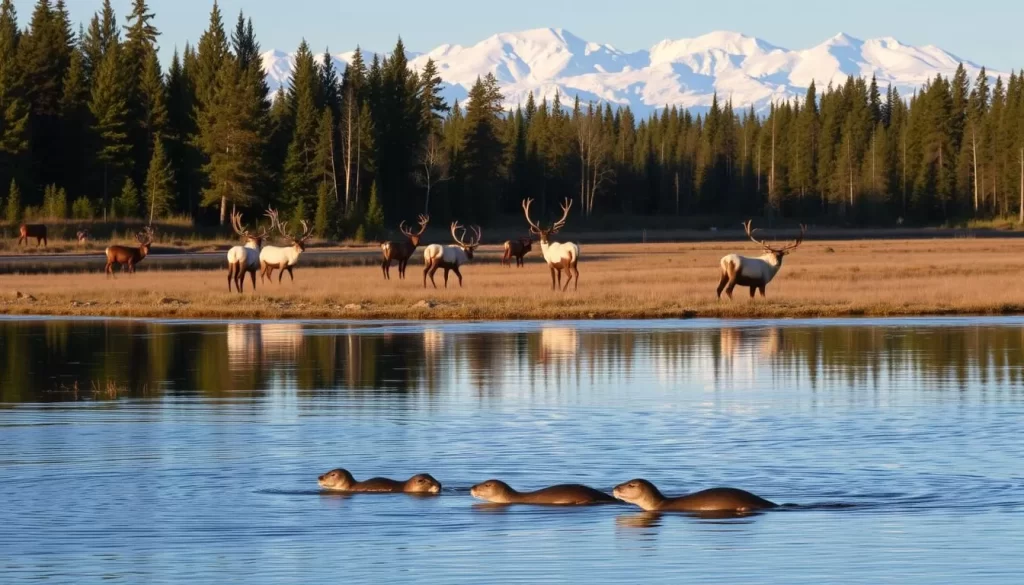
Best Months for Spotting Moose and Bears
The month of May is particularly good for spotting moose, as they tend to be more active during this time. For bears, the summer months of June and July are ideal, as they are often seen roaming in search of food. Understanding the behavior of these animals during different seasons can enhance your viewing experience.
- Moose are more active in May, making it a prime time for viewing.
- Bears are more visible during June and July.
Bird Watching Calendar
Wasilla’s bird watching calendar is marked by distinct seasonal patterns. The spring migration brings thousands of waterfowl and shorebirds to the area’s wetlands in April and May. During June through August, the nesting season offers a chance to see resident species raising their young. Bald eagles are active year-round but are particularly visible during salmon runs from June to September.
- April and May: Spring migration with waterfowl and shorebirds.
- June to August: Nesting season for resident species.
- September and early October: Fall migration with different species.
Planning Your Trip to Nearby Attractions
To make the most of your trip to Wasilla, consider exploring the surrounding area, which offers a range of unforgettable experiences. The region is home to several world-class attractions that are easily accessible from this Alaskan town.
Denali National Park Access from Wasilla
One of the most popular destinations near Wasilla is Denali National Park. Located about 175 miles northwest of Wasilla, the park is a must-visit for nature lovers and adventure seekers. You can reach the park via the Parks Highway, which is typically open year-round, although some facilities may be closed during the winter months. The drive takes around 3-4 hours, depending on traffic and road conditions. Be sure to plan your visit according to the season, as the park’s wildlife viewing opportunities vary throughout the year.
Matanuska Glacier and Hatcher Pass Seasonal Access
The Matanuska Glacier and Hatcher Pass are two more spectacular natural attractions that can be visited as day trips from Wasilla. The Matanuska Glacier, located about 100 miles northeast of Wasilla, offers year-round access, with guided tours available in all seasons. In contrast, Hatcher Pass, just 25 miles from Wasilla, provides year-round recreation, but with different activities depending on the season. During the summer, you can drive the scenic road, explore the historic Independence Mine, and enjoy hiking trails. In the winter, Hatcher Pass transforms into a snow sports paradise, with snowmobiling, cross-country skiing, and snowshoeing available. Visiting these places will enhance your Wasilla experience.
Packing Essentials for Wasilla’s Variable Weather
Packing for a trip to Wasilla requires careful consideration due to the city’s diverse weather conditions throughout the year. The city’s climate varies significantly from one month to another, making it essential to pack accordingly.
Layering Strategies for All Seasons
Layering is a crucial strategy when it comes to packing for Wasilla. It allows you to adjust your clothing to suit the changing weather conditions. For summer, pack lightweight, moisture-wicking clothing. In winter, focus on insulated, waterproof gear.
For transitional periods like spring and fall, include medium-weight insulating layers and waterproof jackets.
Must-Have Gear by Month
Here’s a breakdown of the essential gear for each month:
- January-February: Insulated parka, snow pants, thermal base layers, insulated waterproof boots, heavy mittens, balaclava, and chemical hand warmers.
- March-April: Winter gear with lighter insulation, waterproof boots, sunglasses, and traction devices for icy conditions.
- May: Waterproof hiking boots, rain gear, medium-weight insulating layers, light gloves, sun hat, sunglasses, and bug repellent.
- June-July: Lightweight clothing, rain jacket, sun protection, insect repellent, and light fleece.
- August: Similar to June-July, with a slightly warmer mid-layer and polarized sunglasses for fishing.
- September: Medium-weight insulating layers, waterproof boots, rain gear, light gloves, warm hat, and a packable down jacket.
- October: Cold-weather gear with flexibility for warmer days, ice grippers, and gloves for photography.
- November-December: Full winter gear, including insulated parka, snow pants, thermal layers, insulated waterproof boots, heavy gloves, warm hat, and reflective clothing.
| Month | Essential Gear |
|---|---|
| Jan-Feb | Insulated parka, snow pants, thermal base layers |
| Mar-Apr | Winter gear with lighter insulation, waterproof boots |
| May | Waterproof hiking boots, rain gear, medium-weight layers |
| Jun-Jul | Lightweight clothing, rain jacket, sun protection |
| Aug | Similar to Jun-Jul, with a warmer mid-layer |
| Sep | Medium-weight layers, waterproof boots, rain gear |
| Oct | Cold-weather gear, ice grippers, photography gloves |
| Nov-Dec | Full winter gear, insulated parka, snow pants |
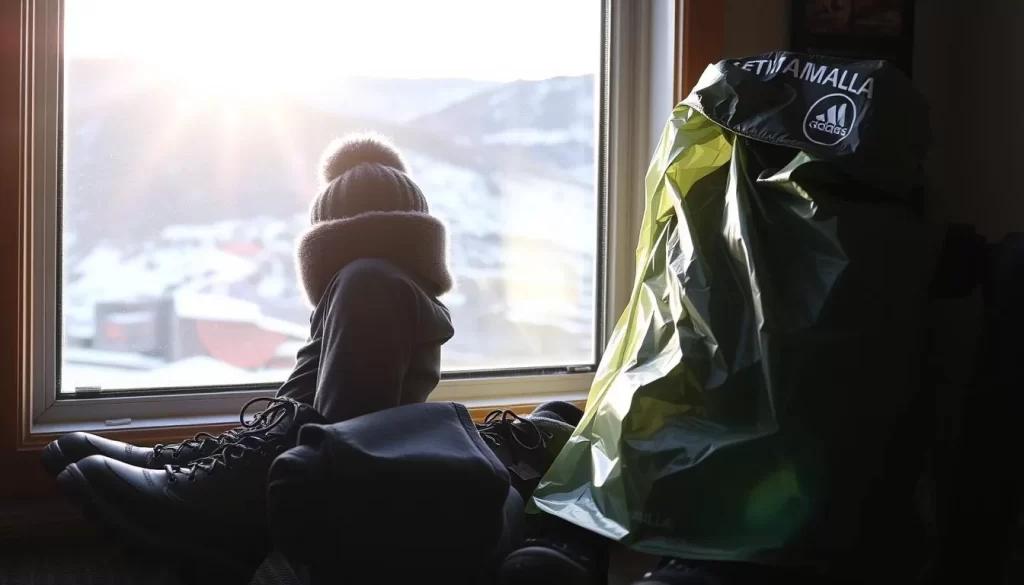
Accommodation and Transportation Considerations
Wasilla’s unique climate and geography make accommodation and transportation considerations vital for a successful trip. Understanding the dynamics of the area will help you plan a more enjoyable and stress-free journey.
Peak vs. Off-Season Availability and Pricing
Accommodation and transportation options in Wasilla vary significantly between peak and off-season periods. During peak season (May to September), you can expect higher prices and greater demand for services. Booking your accommodations and arranging transportation in advance is crucial to avoid higher rates and availability issues. In contrast, the off-season may offer more affordable options, but you should be prepared for potential limitations in service.
| Season | Accommodation Prices | Transportation Availability |
|---|---|---|
| Peak (May-Sep) | Higher | High |
| Off-Season (Oct-Apr) | Lower | Moderate to Low |
Weather-Related Travel Challenges
Weather conditions play a significant role in travel to and around Wasilla. Winter travel presents the most significant challenges, with potential flight delays, road closures, and difficulties driving on snow and ice. Rental vehicles should be equipped with winter tires, and 4WD/AWD is highly recommended for exploring beyond main highways. Spring “breakup” season can create muddy conditions, limiting access to some attractions. Summer generally has fewer weather-related challenges, but fall can bring early snow events.
- Winter: Flight delays, road closures, and driving difficulties
- Spring: Muddy conditions on unpaved roads and trails
- Summer: Generally fewer weather-related challenges
- Fall: Early snow events and temporary driving challenges
Local Events and Festivals Weather Timeline
Wasilla’s calendar is filled with exciting events and festivals throughout the year, each with its own unique weather characteristics. Whether you’re visiting in the dead of winter or the height of summer, there’s always something happening in Wasilla.
Annual Celebrations and Their Typical Weather Conditions
Wasilla hosts a variety of events and festivals that are influenced by the season’s weather. Some of the notable events include:
- February: The Iditarod Restart often takes place near Wasilla, with typical temperatures between 5-25°F and reliable snow conditions.
- Late February/Early March: Iron Dog Snowmobile Race events experience temperatures from 0-25°F with established snowpack.
- May: Spring Celebration events enjoy increasingly warm temperatures between 45-65°F, with occasional rain showers.
- June: Summer Solstice celebrations coincide with the year’s longest daylight period, with pleasant temperatures from 55-75°F.
- July: Independence Day celebrations and the Wasilla Frontier Days enjoy the warmest weather, with temperatures from 60-80°F.
- August: Alaska State Fair in nearby Palmer experiences typical temperatures from 55-75°F, with increasing possibility of rain showers.
- September: Fall Festival events take place as temperatures cool to 45-65°F, with beautiful fall foliage.
- December: Winter holiday celebrations embrace the season’s cold and dark, with temperatures typically between 5-25°F.
Understanding the typical weather conditions for these events can help you plan your trip and make the most of your time in Wasilla.
Conclusion
Determining the best time to visit Wasilla requires considering the activities and experiences that matter most to you. Whether you’re drawn to summer’s warmth or winter’s snowy landscapes, Wasilla offers a unique Alaskan adventure. The prime time for a visit is from June 15 to July 15, balancing optimal weather with peak wildlife activity. However, each season has its charm: fall brings colorful foliage, winter offers northern lights, and spring welcomes renewal. Proper preparation for Wasilla’s variable weather ensures a comfortable trip. By choosing the right time to visit, you’ll create lasting memories.
The above is subject to change.
Check back often to TRAVEL.COM for the latest travel tips and deals.
